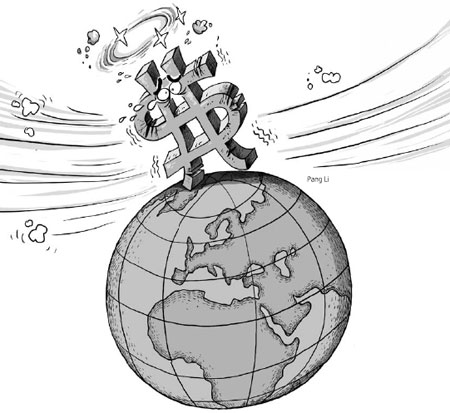
|
OPINION> OP-ED CONTRIBUTORS
 |
|
Avoid dollar trappings to escape its trap
By Yang Mu and Lim Tin Seng (China Daily)
Updated: 2009-06-19 07:46
 The massive public debt incurred by governments because of the global financial crisis seems to have prompted the inflation monster, which caused havoc across the world in 2007, to raise its head again. The recent hike in oil prices - from about $40 a barrel in March to more than $70 a barrel and a 20 percent increase in raw material prices during the same period are indications that inflation has started setting in. Another sign is the price of gold futures, which has crossed $1,000 an ounce. Inflation is set begin in the US where money supply seems to have spiraled out of control. Since the collapse of Lehman Brothers in September 2008, the Federal Reserve has been printing huge amounts of currency notes to fund its bailout packages and increase employment. At the same time, the US has adjusted its interest rate to a historic low of almost zero percent. Given its loose monetary policy, it is not surprising to see US government debt ballooning from about $500 billion to more than $2 trillion in just six months, from September 2008 to May 2009. The US debt is set to mount further because the Fed announced in March that it would continue to "buy" out America's financial problems, starting with $300 billion worth of Treasury bonds by September. It will follow it up by buying $200 billion in bonds and $1.25 trillion in mortgage-backed securities issued by Fannie Mae and Freddie Mac by the end of this year. Inflationary pressure will come from countries that have adopted US-type tactics to emerge out of recession, too. According to new IMF estimates, public debts of the 10 leading economies will rise from 78 percent of GDP in 2007 to 114 percent by 2014. That means these governments will owe about $50,000 for each of their citizens. More importantly, it indicates there is a high possibility of these governments depending on inflation to clear their debts. The imminent arrival of a second round of inflation is no good news for the US dollar. Signs of a weakening dollar can already be seen, with yields of the 10-year Treasury bill increasing from about 2 percent at the end of 2008 to almost 4 percent earlier this month. The strengthening of the euro's and other currencies' exchange rates against the US dollar in recent months is another bad news for America. As the global economy recovers, there will be more downward pressure on the US dollar as investors become less risk averse and have less need for dollar security. With this trend developing, the world could plunge into a "US dollar trap". Coined by Economics Nobel laureate Paul Krugman in one of his columns in The New York Times, the concept was first applied to the loss China's huge foreign reserves would suffer if the US dollar depreciated. But in truth, the passing on debt because of a weakening dollar will not only affect China, but the whole world. Such a dire situation, however, could be prevented if economies across the world find an effective "exit strategy" to unwind themselves from the emergency actions they have taken to free credit markets and boost demand. This will not be an easy task but could be realized if the economies are willing to act collectively and responsibly just like they did when the global financial crisis set in. One of the first steps could be working out a coordinated effort through international groupings or institutions such as the G8, G20 or the IMF to stabilize the global monetary situation. This may include outlining guidelines on how and when to start tightening monetary policies, raising taxes and restricting money supply. Other steps may require countries, especially Brazil, Russia, India and China (or BRIC), which hold large amounts of US dollar-denominated assets such as government bonds and Treasury bills to conduct a gradual rather than massive sell-off of these assets as the dollar weakens. This is to ensure the stability of the US dollar in order to prevent the global economy from falling into the US dollar trap. The US government could help prevent devaluation of the dollar by issuing foreign currency-denominated securities to raise funds abroad. These types of bonds are not new because they were introduced in the late 1970s in Germany and Switzerland as Carter bonds. In December 2008, Japan revived this idea by pushing the Barack Obama administration to issue US Treasury bonds denominated in yen and other currencies to reduce the risk of holding US dollar-denominated debt. Perhaps one of the most effective steps will be to reduce the global economy's dependency on the US dollar. Finding an alternative solution is a massive task because it requires not only institutional changes in monetary bodies such as the IMF, but also the setting up of a new world currency order. This idea, however, has already being explored on a preliminary level among BRIC economies, which have been discussing using their currencies instead of the US dollar in bilateral trade. In fact, some agreements have been reached on currency swap to provide short-term foreign exchange liquidity and help boost bilateral trade and investment. The authors are researchers at East Asian Institute, National University of Singapore. (China Daily 06/19/2009 page9) |